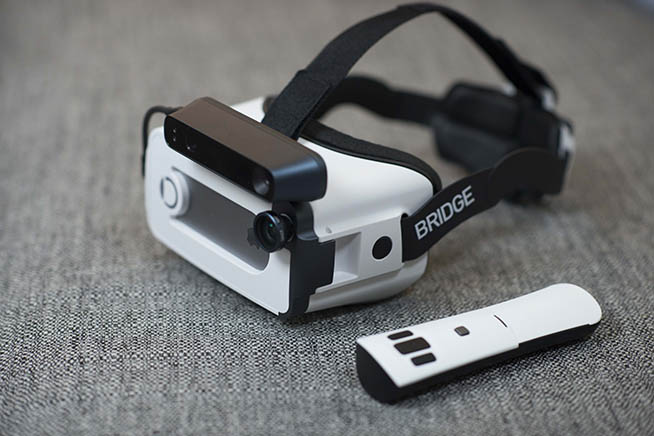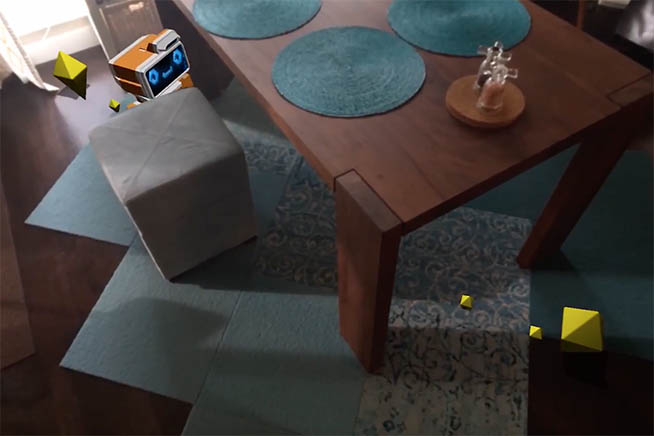The wearable creates an experience for users that combines virtual and augmented reality. Bridge will go on sale in March for $399
Imagine interacting with a virtual robot inside a room. Imagine also opening a door inside a real wall. Science fiction? Absolutely not. Thanks to the new Bridge visor, in fact, we could move in the real and virtual world at the same time.
The device, in fact, maps the surrounding world and creates a virtual space where some virtual objects can interact with users. As Occipital, the company behind the wearable, writes on its website, "virtual objects enter our world and interact with our environment as if they were really there." The visor for some traits is reminiscent of Microsoft's Hololens, the glasses for augmented reality. Come il dispositivo di Redmond, Bridge, infatti, proietta nel mondo reale elementi virtuali. Ma Bridge è anche simile ad altri visori VR. In altre parole, il device di Occipital unisce la realtà virtuale e quella aumentata in un unico oggetto.
Caratteristiche
(Tratto da YouTube)
Partiamo dicendo che Bridge è un dispositivo pensato per funzionare solo con gli iPhone e gli iPad. Il cuore del wearable è costituito da Structure Sensor, uno scanner 3D per i dispositivi Apple creato sempre da Occipital. Il compito di Structure Sensor è appunto mappare la realtà e creare un’esperienza di mixed reality dentro cui gli utenti interagiscono con oggetti fisici e virtuali. Structure Sensor è anche dotato di alcuni sensori posizionali di tracking inside-out che consentono di muoversi liberamente all’interno dello spazio AR/VR proiettato dal visore. Questo significa che non è più necessario tracciare la stanza con altri sensori e fotocamere.
Un visore unico

Bridge è un visore unico nel suo genere
Bridge è un visore unico. È il primo dispositivo così performante nella realtà mista che non ha bisogno di un potente PC desktop di supporto o di telecamere esterne. Può interagire con la realtà e modificare le immagini mostrare usando unicamente i sensori presenti all’interno e all’esterno del visore. Un aspetto che permette all’utente di muoversi comodamente all’interno di una stanza o di un luogo senza pericoli. E questa funzionalità rende il visore molto appetibile per i videogame. Non ha solo pregi ed essendo il primo nel suo genere presenta anche alcuni difetti. Chi lo ha provato ha assicurato che dopo alcuni minuti può insorgere la nausea, in più sfruttando lo schermo dell’iPhone la risoluzione si abbassa a 640 x 480 calcolando la visione binoculare.
A cosa servirà l’suo di visori come Bridge?
 Fonte foto: Bridge
Fonte foto: Bridge
Le applicazioni presenti in Bridge
Quale sarà in futuro l’uso intensivo di visori per la realtà mista? Il primo pensiero è per il gaming ma Jeff Powers, CEO di Occipital ha altri progetti per il suo dispositivo: “La base dei videogames è ricreare mondi diversi dal nostro, non so quanto gli sviluppatori vogliamo ideare un gioco che parte dalla realtà comune dei giocatori. È possibile che progetti così abbiano poco appeal”. Il prossimo futuro pronosticato da Occipital per Bridge è nella scelta degli interni e degli arredamenti. Using the viewer, in fact, you will be able to modify your furniture with the ones you want and see the final effect. Change your kitchen or sofa knowing how it will look in your home even before you buy them.
Price and launch date
It attaches to the head with a strap and we can use the commands of the viewer thanks to a small Bluetooth remote control, just as it does in the Google DayDream. It will hit the market starting next week for a price of just under $500. But only a few hundred devices will be released. Occipital wants to test the product before opening it up to a wider audience. While in March 2017, the company will expand the number of visors produced and the price will drop to $399. The device will be on sale on the manufacturer's website and it will be possible to buy it in Europe as well.
